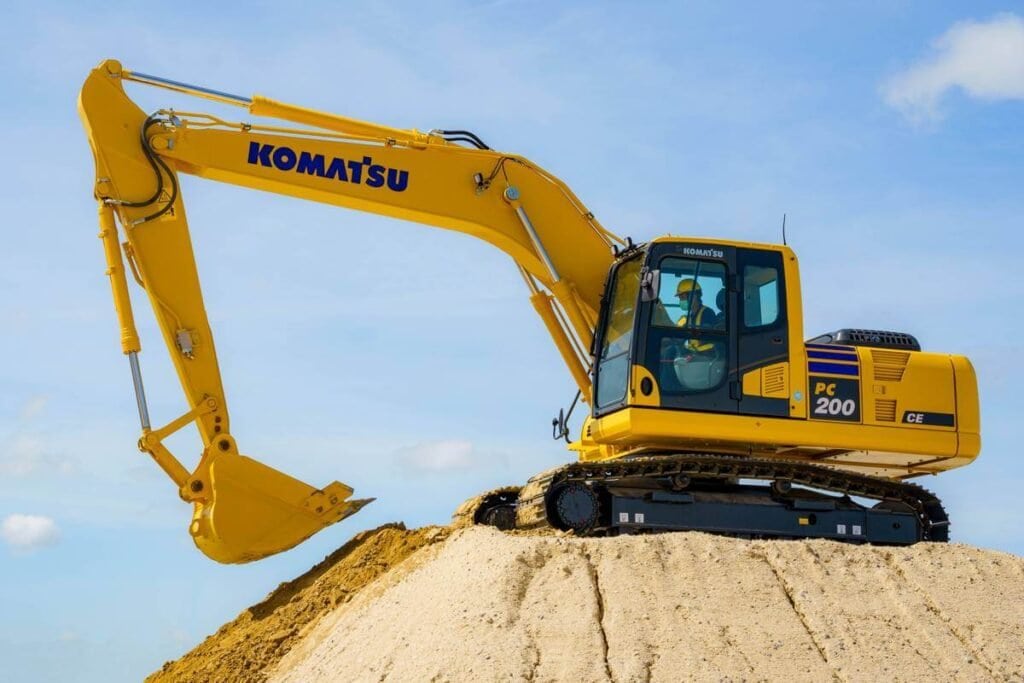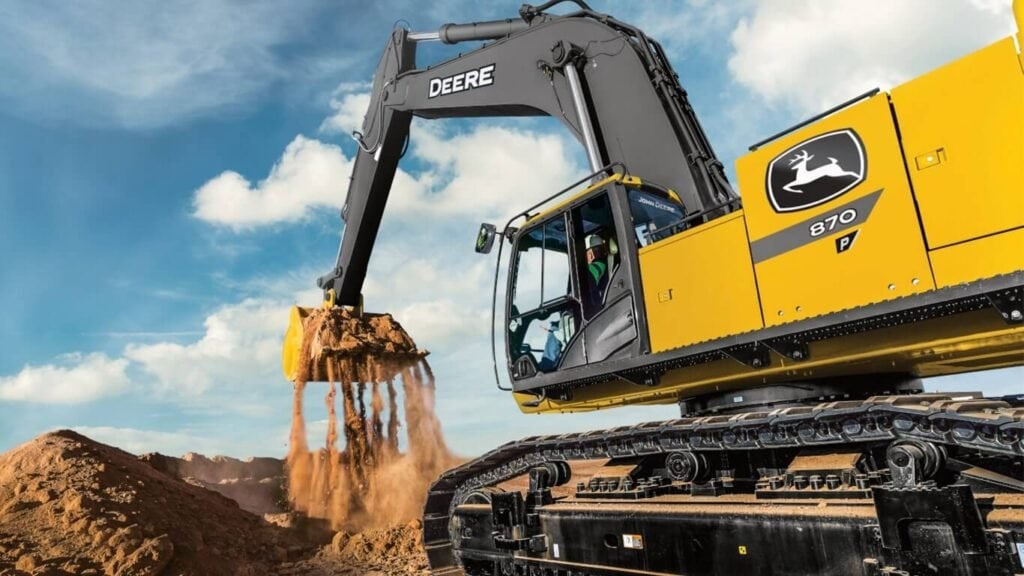Need a powerful machine to dig, lift, and demolish? How the function of an excavator drastically transforms construction efficiency and capabilities all over the world.
The function of excavator includes digging, trenching, lifting, demolishing, grading, and loading. This excavator machine uses hydraulic systems to operate its boom, arm, and bucket on a tracked or wheeled chassis. Its versatility makes it essential in modern construction projects, from building foundations to large-scale mining and earthmoving.
So let’s go through each function, each type, and each part, and tell you how to use them in real-world, practical applications.

What Are the Main Functions of an Excavator?
Excavating—the function of an excavator in construction goes well beyond digging holes. As a true workhorse construction digger, the excavator is invaluable at site preparation and material handling. Built at its heart to speed up and make easier more complicated tasks, as well as make you and your team safer. Whether you’re working with pipelines, building foundations, or grading out a new road, knowing about excavator functions helps you pick the right model.
Excavators can dig trenches for utilities or foundations, demolish old buildings and structures, lift and place heavy materials, or even handle fine grading or landscaping work. With attachments like augers for drilling, grapples for handling irregularly shaped items, or breakers for demolition, an excavator can do a wide variety of tasks on the construction site. It can load trucks, clear debris, or compact soil, all depending on how you equip the machine.
Today’s excavators, including mini-excavators, crawler excavators, and backhoe excavators, are all equipped with hydraulic systems that provide specialized capabilities. On large projects, dragline excavators are used for mining; suction excavators are used for delicate work around underground utilities. These machines are invaluable, and the right use of an excavator can dramatically increase productivity and reduce labor costs on a construction project.
For example, when looking at a cat 320 excavator for sale, it’s because you know it’s a versatile performing machine. Whether you’re inquiring about excavator operator jobs or researching excavator for sale listings, knowing what an excavator does helps you make better decisions.

How Does an Excavator Work Mechanically?
Understanding how do excavators work is critical when buying or operating one. The heart of the machine is the hydraulic system in excavator that makes fluid-powered movement possible. A typical unit has a boom, dipper (or arm), and bucket all powered by pressurized hydraulic oil delivered through pumps and valves.
The tracks (or wheels) support the undercarriage. The cab rotates 360° to enable versatile operation. You control each movement with joysticks and pedals—whether you’re lifting loads or rotating the upper structure. The fuel-efficient engines (like the ones in the CAT 308 excavator or Komatsu excavator) drive the pumps.
Whether you’re renting a mini excavator or buying a Hitachi mini excavator, you need to understand what makes these things go. A well-maintained hydraulic excavator moves smoothly, saves fuel, and doesn’t cause as much damage. The Volvo excavator, Liebherr excavator, or Sany excavator—all the best excavator brands—will tell you that it’s all about the hydraulics!
Whether you’re a buyer looking for a Temu excavator or sifting through used excavator listings, you need to understand that is how these things work. Knowing the parts of an excavator and the functions they perform is also critical to operate the machine safely and make sure it lasts.

What Role Does the Bucket Play in Excavator Tasks?
The bucket is probably the most recognizable and used part of an excavator. It’s attached to the end of the dipper arm and is responsible for digging, scooping, and moving dirt or debris. There are different sizes, shapes, and materials for buckets designed for different jobs.
You might have a mini excavator that has a narrow trenching bucket, but you might have a Cat 330 excavator for sale, and it’s got a heavy-duty rock bucket on it. Maybe you’ve got a tilt bucket for it because you’re doing some precision grading, or maybe you’ve got a clamshell bucket for it because you’re doing that vertical excavation.
Bucket design directly impacts excavator performance. Whether you’re running a case excavator or cat excavator, choosing the correct bucket makes a big difference in speed and efficiency. The high-end models, like the Cat 390f specs or cat 323f price, are designed for huge- capacity buckets when doing large jobs. On smaller job sites, running micro excavator units with tilt buckets lets you work in tight spots. If you are planning to buy an excavator for sale, be sure to think about how different bucket configurations will work with the plan you have in mind.

Why Are Excavators Crucial in Construction Projects?
The place of the excavator in construction work is crucial. The efficiency of construction work depends largely on how well you work the machinery. Early in earthmoving and late in material handling, the use of excavators will allow you to move forward faster with fewer guys.
An excavator is also safer. You can keep your men and laborers out of harm’s way. An excavator can lift much heavier things than any team of humans and work around the clock with very little rest. For mid-size site work, a model like the Cat 315 sale gives you a lot of reach, and it’s a very capable machine.
In construction, you use an excavator for digging trenches, preparing foundations, demolition, site clearing, lifting pre-cast panels, and a whole host of other activities. In infrastructure, a railroad employs excavator railway units to maintain the tracks. The dragline excavators work in open-pit mining. Whether you are looking for a temu mini excavator, a Kubota mini excavator, or a full-sized Cat 390 long reach, you have to know which tool to use for which job. If you are in the business of renting these things, explain the benefits so they can understand the value.

What Are the Different Excavator Types and Sizes?
There are many types of excavator—each designed for specific tasks. Categories are based on size, mobility, and function. The most common types include:
- Mini Excavator (micro to 6 tons): compact, agile, used in landscaping or residential work.
- Crawler Excavator (6–90 tons): versatile tracked models used for general construction.
- Wheeled Excavator: better on paved roads or urban settings.
- Dragline Excavator: massive machines for mining or marine work.
- Suction Excavator: used in utility and municipal jobs.
- Backhoe Excavator: combines loader and excavator features.
If you sell excavators, teach people how to size an excavator properly for the size of the job. Use an excavator size guide to help them make the right decision. The Mecalac excavator (excavator Mecalac) has a certain size range. The Cat excavator (excavator Cat) and the Komatsu excavator (excavator Komatsu) cover a range. If you are tight on a budget, you might look at a used excavator or a mini excavator for sale. A lot of people buy Chinese excavator brands because of the price. If you are a wholesaler or a distributor of excavators, try to carry different types and sizes of excavators to serve a wider market.

What Are the Key Parts of an Excavator?
Every excavator contains critical components that work together. The core parts of an excavator include:
- Cab: operator space with controls
- Boom, Arm, Bucket: primary working parts
- Undercarriage: tracks or wheels
- Engine: drives power and hydraulics
- Hydraulic System: powers movement
- Swing Motor: rotates upper body
- Counterweight: balances heavy loads
Every single part must be durable and responsive. For example, if you’re considering the excavator machine, are the tracks in good condition? Because if they’re not, the excavator’s not going to work well. Are the hydraulics in good condition? If not, it’s not going to have the power. Cat, Volvo, and Komatsu design it every single part to work together. The temuexcavator, the excavator mini, or the lower-cost manufacturers may not. So, you have to do a detailed inspection and understand the parts of the excavator and their functions, and make before you think about buying.

How Does a Crawler Excavator Differ From a Wheel Excavator?
Crawler excavators and wheeled excavators serve different needs. The crawler excavator runs on tracks, which works well for rough terrain and gives it a stable base, making it perfect for heavy-duty applications like mining or demolition. Wheeled excavators are faster on the road and are better suited for urban environments or lighter construction work, like bridges.
Crawler excavators like the Cat 320F price unit are tough and stable, but they’re difficult to move if you spend a lot of time travelling from one paved job site to another. In that case, you’re better off with a wheeled version or a backhoe excavator. The decision depends on your terrain, transportation cost, and your lifting needs. Crawler excavators are popular in developing countries because they are so versatile.
Summary
From digging to dentistry, the role of the excavator is enormous and literally covers the map. Being comfortable with the various types, parts, and uses will help when it comes time to buy, rent, or use an excavator.